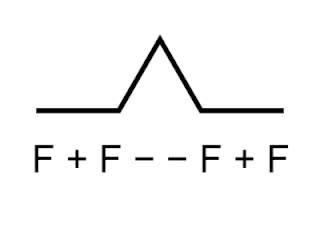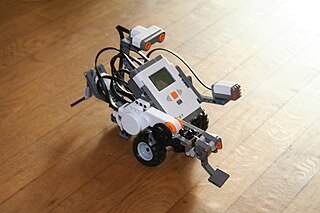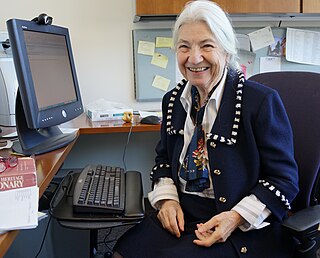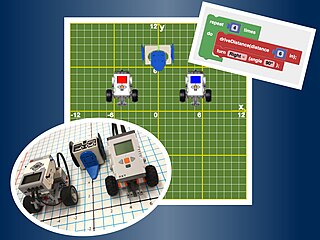
Logo is an educational programming language, designed in 1967 by Wally Feurzeig, Seymour Papert, and Cynthia Solomon. Logo is not an acronym: the name was coined by Feurzeig while he was at Bolt, Beranek and Newman, and derives from the Greek logos, meaning word or thought.

The University of California, Berkeley College of Engineering is the engineering school of the University of California, Berkeley, a public research university in Berkeley, California.

In computing, a visual programming language, also known as diagrammatic programming, graphical programming or block coding, is a programming language that lets users create programs by manipulating program elements graphically rather than by specifying them textually. A VPL allows programming with visual expressions, spatial arrangements of text and graphic symbols, used either as elements of syntax or secondary notation. For example, many VPLs are based on the idea of "boxes and arrows", where boxes or other screen objects are treated as entities, connected by arrows, lines or arcs which represent relations.

UC Davis Medical Center (UCDMC) is part of UC Davis Health and a major academic health center located in Sacramento, California. It is owned and operated by the University of California as part of its University of California, Davis campus. The medical center sits on a 142-acre (57 ha) campus (often referred to as the Sacramento Campus to distinguish it from the main campus in nearby Davis) located between the Elmhurst, Tahoe Park, and Oak Park residential neighborhoods. The site incorporates the land and some of the buildings of the former Sacramento Medical Center (which was acquired from the County of Sacramento in 1973) as well as much of the land (and two buildings) previously occupied by the California State Fair until its 1967 move to a new location.

Lego Mindstorms NXT is a programmable robotics kit released by Lego on August 2, 2006. It replaced the Robotics Invention System, the first-generation Lego Mindstorms kit. The base kit ships in two versions: the retail version and the education base set. It comes with the NXT-G programming software or the optional LabVIEW for Lego Mindstorms. A variety of unofficial languages exist, such as NXC, NBC, leJOS NXJ, and RobotC. A second-generation set, Lego Mindstorms NXT 2.0, was released on August 1, 2009, with a color sensor and other upgrades. The third-generation EV3 was released in September 2013.

Eric Paulos is an American computer scientist, artist, and inventor, best known for his early work on internet robotic teleoperation and is considered a founder of the field of Urban Computing, coining the term "urban computing" in 2004. His current work is in the areas of emancipation fabrication, cosmetic computing, citizen science, New Making Renaissance, Critical Making, Robotics, DIY Biology, DIY culture, Micro-volunteering, and the cultural critique of such technologies through New Media strategies.
Ernest Lenard (Ernie) Hall, PhD, PE, is Professor Emeritus of Mechanical Engineering and Computer Science in the School of Dynamic Systems in the College of Engineering and Applied Science at the University of Cincinnati. He was also the Paul E. Geier Professor of Robotics in the Department of Mechanical Engineering at the University of Cincinnati. He has also held joint appointments at the University of Cincinnati with the Department of Electrical and Computer Engineering and Computer Science. He regularly collaborates with faculty and students in other colleges at University of Cincinnati, as well as civic groups, including the FIRST Lego League, the Ohio Academy of Science, and the Society of Manufacturing Engineers. While consulting with the Oak Ridge National Laboratory, he became interested in efforts to make useful robots for some of the dangerous tasks encountered by the Department of Energy, Department of Defense and NASA. He noted the importance of combining image processing algorithms with manipulators and controller to build intelligent robots, especially in automatic target recognition. He has founded and has co-chaired an annual conference on Intelligent Robots and Computer Vision for the past 25 years to provide a forum for new innovations in this field. He sits as the first Paul. E. Geier Professor of Robotics at the University of Cincinnati. At the University of Cincinnati, he established the Center for Robotics Research, which encourages robotics activities in industry, medicine, defense, and even at home with projects like a robot lawn mower. He also founded the UC Robot Team that has participated in the Intelligent Ground Vehicle Competition for the past 15 years and the DARPA Grand Challenge in 2005 and 2007. He has also served as a judge for the Cincinnati FIRST Lego League for two years and has been called the Woodie Flowers of Cincinnati for giving the Gracious Professionalism award. In 2006, Ernest L. Hall won the Grand Prize in the "Made in Express" contest sponsored by Microsoft. His entry for the contest was an all-terrain self-maneuverable robot developed using Microsoft Visual Studio Express. He donated the $10,000 cash prize from the contest back to the University of Cincinnati to support robotics.
Henrik Iskov Christensen is a Danish roboticist and Professor of Computer Science at Dept. of Computer Science and Engineering, at the UC San Diego Jacobs School of Engineering. He is also the Director of the Contextual Robotics Institute at UC San Diego.

John F. Canny is an Australian computer scientist, and Paul E Jacobs and Stacy Jacobs Distinguished Professor of Engineering in the Computer Science Department of the University of California, Berkeley. He has made significant contributions in various areas of computer science and mathematics, including artificial intelligence, robotics, computer graphics, human-computer interaction, computer security, computational algebra, and computational geometry.

Ruzena Bajcsy is an American engineer and computer scientist who specializes in robotics. She is professor of electrical engineering and computer sciences at the University of California, Berkeley, where she is also director emerita of CITRIS.

The Henry Samueli School of Engineering (HSSoE) is the academic unit of the University of California, Irvine that oversees academic research and teaching in disciplines of the field of engineering. Established when the campus opened in 1965, the school consists of five departments, each of which is involved in academic research in its specific field, as well as several interdisciplinary fields. The school confers Bachelor of Science, Master of Science, and Doctor of Philosophy degrees.

Harold Cohen was a British-born artist who was noted as the creator of AARON, a computer program designed to produce paintings and drawings autonomously. His work in the intersection of computer artificial intelligence and painting lead to exhibitions at many museums, including the Tate Gallery in London.

Linda Pisti Basile Katehi-Tseregounis is a Greek-born American engineering professor and former university administrator. Katehi was elected a member of the National Academy of Engineering (2006) for contributions to three-dimensional integrated circuits and on-wafer packaging and to engineering education. Katehi worked as the University of Illinois Urbana-Champaign's provost from 2006 to 2009 and dean of engineering at Purdue University from 2002 to 2006. Beginning in 2009, she served as the sixth chancellor of the University of California, Davis.
CH is a proprietary cross-platform C and C++ interpreter and scripting language environment. It was originally designed by Harry H. Cheng as a scripting language for beginners to learn mathematics, computing, numerical analysis, and programming in C/C++. Ch is now developed and marketed by SoftIntegration, Inc., with multiple versions available, including a freely available student edition and CH Professional Edition for Raspberry Pi is free for non-commercial use.

C-STEM is a UC-approved educational preparation program for undergraduate admission for UC campuses to prepare students for college and career. C-STEM has University of California A-G Program status. High schools can add the A-G approved rigorous C-STEM curriculum to their own school’s A-G course lists for the UC/CSU admission requirements.

RoboBlockly is a web-based robot simulation environment for learning coding and math. Based on Blockly, it uses a simple puzzle-piece interface to program virtual Linkbot, Lego Mindstorms NXT and EV3, as well as to draw and animate for beginners to learn robotics, coding, math, science, and art. Blocks in RoboBlockly can be executed in debug mode step-by-step. All math activities in RoboBlockly are Common Core State Standards Mathematics compliant.

Normaliz is a free computer algebra system developed by Winfried Bruns, Robert Koch (1998–2002), Bogdam Ichim (2007/08) and Christof Soeger (2009–2016). It is published under the GNU General Public License version 2.

Chan-Jin Chung, commonly known as CJ Chung, is a full professor of computer science at Lawrence Technological University (LTU) in Michigan, USA. He founded an international autonomous robotics competition called Robofest in the 1999–2000 academic year as well as numerous educational programs for youth by integrating STEM, arts, autonomous robotics, and computer science. He also served as the founding USA National Organizer of World Robot Olympiad (WRO) in 2014 and 2015. He also started the WISER conference in 2014. He is working on developing a computer science curriculum for connected and autonomous vehicles (CAV) with a support from National Science Foundation . His research areas include evolutionary computation, cultural algorithms, intelligent systems & autonomous mobile robotics, software engineering,
"Why Women Don't Code" is an essay by University of Washington computer science lecturer Stuart Reges, published in Quillette in June, 2018. The essay, addressing gender disparity in computing, became "one of the most read" items posted in Quillette in 2018 after a link to it was tweeted by Jordan Peterson.















